Forged By Fire
Bespoke blades as a badge of culinary and sporting sophistication.
The furnace breathes like a living thing, exhaling air that feels hotter than the surface of the sun. Knifemaker Will Manning extracts the orange-red material with tongs and transfers the glowing metal to an anvil. He pounds and pounds, leaning into each hammer strike. This is just one step in the long, arduous process, as the metal slowly transforms from raw bar stock into something both functional and beautiful.
Though Manning once worked as a living-history blacksmith, today he focuses his efforts on creating sharp-edged culinary tools for harvesting and preparing food. He is not alone as a leader in the bladesmithing renaissance. The American Bladesmith Society (ABS) reports a growing interest in the craft, saying, “We had 832 members in 2009, in 2015 we had 1,165 and by 2025 we have as many as 2,800.” This statistic does not count the thousands of knife-makers who are not affiliated with the ABS.

Will Manning grinding down blade (Images Provided by Nick Kelley, Geoff Wood and David Fason)
Outdoorsmen are now opting for custom tools that hold their edges through countless field dressings, and chefs are reaching for blades that slice and dice with precision. A growing segment of the population is turning toward commissioning custom pieces that can take weeks, even months, to complete, signaling a return to hand-forged craftsmanship.
A HOT HISTORY
During the Iron Age, beginning between 1200 and 600 B.C., blacksmiths revolutionized civilization by mastering working with iron and steel. These skilled craftsmen transformed raw iron ore into durable tools and weapons through intense heating and hammering. Their greatest achievement came with the discovery of steel-making — heating iron with carbon to create a harder and more resilient metal. The Hittites of ancient Turkey were likely the first to perfect this steel-working technique. As blacksmithing knowledge spread throughout Europe, Asia and parts of Africa, entire societies rose beyond the limitations of stone and bronze implements.

Hammer and Anvil
Blacksmiths also played a vital role in America’s development, forging everything from horseshoes to axe blades, nails to knives, with techniques passed down through generations. The clanging of hammer on anvil echoed across every community.
The Industrial Revolution impacted everything, especially blacksmithing. Initially, the era relied on blacksmiths to create the components needed for machinery, but as factories and mass production developed, the demand for hand-forged items declined. By the mid-twentieth century, the ancient craft teetered on the edge of extinction, kept alive only by a handful of passionate artisans.
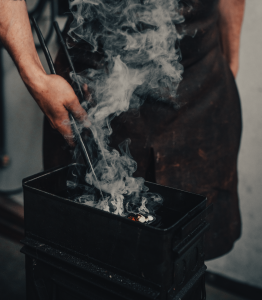
Quenching Process
FIRE, FORGE AND FINESSE
At Bloodroot Blades outside of Athens, Georgia, knifemakers David Van Wyk and Luke Snyder pursue a unique reverence by transforming raw materials into instruments of precision.
“There’s a lot of science — and art — in knifemaking,” says Van Wyk, “We balance the science and the art to create something functional, durable and lovely.”
A custom knife’s life begins not at the anvil, but in conversations between maker and user. This process varies by knife as creation unfolds in several steps — forging, profiling, heat-treating, testing, grinding, finishing and sharpening.
The forging stage sees metal roller bearings from large machines heated to a supernova glow before being hammered and shaped. The profiling comes next, which is coaxing the metal into the familiar silhouette of the knife design.

Blade removed from the forge
Following the initial steps is the delicate dance of heat-treating, involving multiple steps in itself, beginning with normalization. The molecular structure of the steel is reset with a trip to the heat-treating kiln, resulting in an even distribution of the alloying elements in the steel. Thermal cycling heats and cools the blades rapidly to refine the grain structure even further.
In the quenching step, the steel is heated, then rapidly cooled by submerging the piece in vats of brines or oils. “The quenching is a highly controlled step, requiring specific temperatures, soak times and rates of cooling,” Van Wyk says. “If the heat is too high, the steel will be brittle. Too low and it won’t harden.”
After the quench, craftsmen are left with a chemical lattice structure with a Rockwell C hardness (HRC) of approximately 67. This form is hard but brittle, so the last step, tempering, brings the steel to more optimum HRC measurements between 63 and 64.
Pastime to Passion
At Sea Island, commitment to unique experiences extends to the very tools that create memorable moments. Resort Bars and Spirits Manager Nic Wallace has been hand-forging custom blades in his free time for the last five years.

Blade Sharpening
“I remember seeing my grandfather make a knife when I was younger, and I guess I’ve always loved the feeling of making things with my hands,” Wallace says. “A few years back, I bought a small forge and began making knives as a means to learn, create and occupy my mind.”
A month later, Wallace purchased a larger forge to fuel his pastime. Much like bartending, forging a blade begins with a single idea. The craft is an exercise of skill, practice and patience, culminating in an object that possesses beauty and usefulness.
Today, many at Sea Island wield blades crafted from Wallace’s home forge. He crafted a 10-inch chef knife with a Damascus blade and a striking black-and-blue layered-fiber handle for a member of the banquet culinary team, noting that the intricate piece is “razor-sharp with a long-lasting edge.” He’s also crafted utility and paring knives and gifted them to bartenders for special occasions.
In September, one of his masterpieces accompanied him to Toronto’s World Class Global Finals, the world’s most prestigious cocktail competition. He made the 7-inch utility knife from 120 layers of steel and affixed a handle made of a copper-infused carbon fiber and G10, a high-pressure fiberglass laminate used for its strength, durability and lightweight properties.
What began as a leisurely pastime has evolved into a fiery passion, with Wallace and people around him embracing his forged creations as both part of their daily routines and as treasured keepsakes.
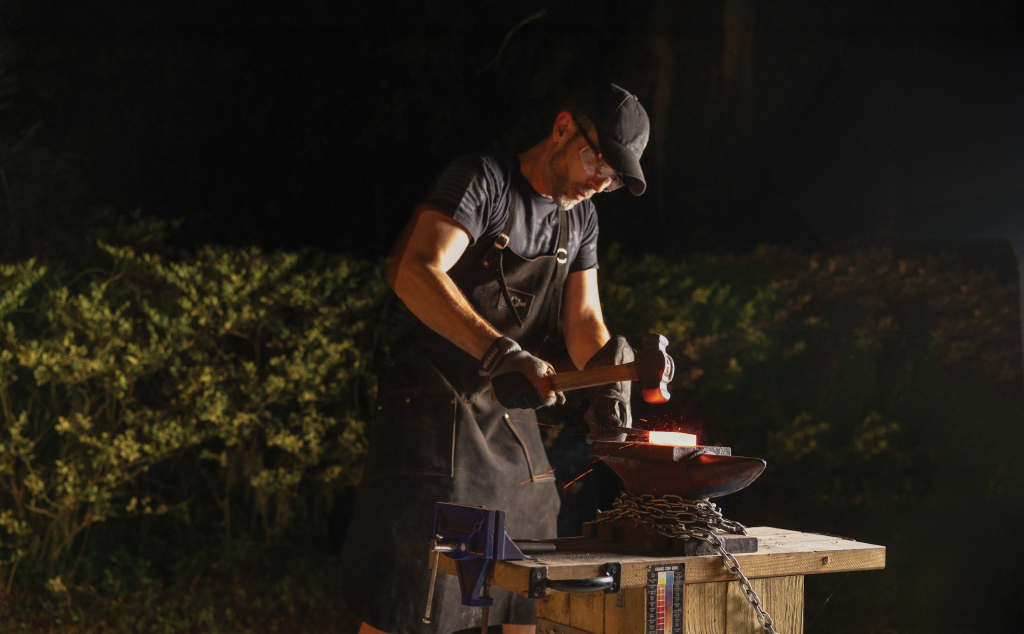
Nic Wallace forging at home.
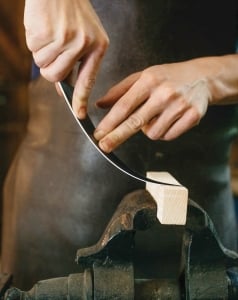
Blade Flexing Test
“Now we have a piece of steel that we can make a quality knife from,” Van Wyk says. “In the grinding and polishing steps, we transform the blade into its final shape, geometry and purpose.”
The process continues with handle attachment using materials such as Georgia pecan wood or red maple, but handles can be crafted from almost anything. “We once made a knife for a U.S. servicemember who wanted a knife to honor his service and mark his retirement,” says Van Wyk. “He provided oak from the Yokosuka dry docks in Japan, fabric laminate of his Battle Dress Uniform and a steel spacer from the deck of the USS Ronald Reagan.”
Upon polishing both the blade and handle and sharpening the knife using Japanese whetstones, these craftsmen have achieved the grand finale of their labor. This culmination of science and artistry produces one-of-a-kind showpieces representing weeks of dedication and unwavering commitment to quality.
METAL WORKS
A knife is defined by the metal that composes it. With craftsmanship at the forefront of hand forging, a knife’s ingredients are shaped by its maker’s personal style. Quality is never a question, but in the discussion of sustainability versus standard, bladesmiths must decide what their metal will be made of. Pushes for sustainability have led to knifemakers switching from traditional steel products to recyclable materials, the key to achieving precision in their product.
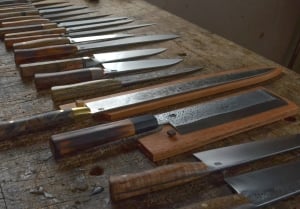
Finished knives from Bloodroot Blades.
Bloodroot Blades built their brand using only recyclable materials in their knives. The variation in metal allows them to create a signature history behind each blade. When determining the composition of each knife, Van Wyk and Snyder are simultaneously opening the door to new people, stories and a gentle impact on the environment.
Knifemakers Daniel Moye and Quintin Middleton of the respective Cattle Dog Forge and Middleton Made Knives utilize the familiar high-carbon steel as one of the sole contributors to the metal behind their blades. In particular, Moye relies on New Jersey Steel Barons, who prioritize consistent high-caliber steel and collaborate with bladesmiths, all while keeping the forging process in mind. Moye and Middleton’s commitment to the standard complements their innovation rather than stifles creativity.
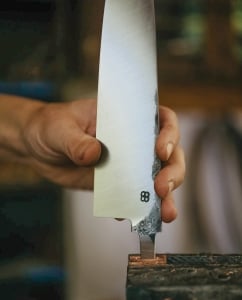
Fitting a guard and handle.
Will Manning of Heartwood Forge combines the practices of Middleton Made Knives, Cattle Dog Forge and Bloodroot Blades in his pursuit of forging his signature knives. Manning uses both recycled and top-grade materials in his blades; an amalgam of sustainability and standard. Many of his knives include unconventional materials, from bourbon barrel straps to the leaf spring of a Toyota Tacoma. These repurposed metals are seamlessly folded into more standard blade-making metals like high carbon steel, pure nickel and copper. Achieving stunning Damascus and layering of metals on his blades, Manning has produced alloys that sit at the crux of metalwork.
Sustainability and standard do not find themselves at odds in the knifemaking industry. They rather illustrate an individual style that shines through in every bladesmith’s personal craft.
A MODERN RENAISSANCE
Today, the revival of blacksmithing, as well as bladesmithing, speaks to a hunger for objects that matter, last and have histories.
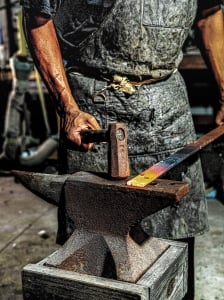
Quintin Middleton beginning the forging process.
Connecting culture to craftsmanship is a “breath of fresh air” to Quintin Middleton. His roots stem from the Gullah Geechee community, historically centered along the southeastern coast. Initially, Middleton shied away from connecting bladesmithing to his background, but his deeper understanding of the resilience of the Gullah Geechee people soon reflected in his work. “They may take nothing and make something that’s usable, that can inspire. From a chef’s standpoint, they’ll take anything that can be curated into a whole meal made with passion and love.”
It takes a unique artistry to create tools that contribute to refining taste, all while emulating a rich and long-lasting history. For Middleton, this skill and passion can be found in each of his blades, in particular his ‘Geechee Boy’ collection that resonates a deep comprehension of history, culture and culinary art into one knife.
At Bloodroot Blade, knifemakers like Van Wyk and Snyder find that the most interesting knives begin with materials that have been salvaged or have already lived one life. In their workshops, knife blades are worked from machinery reclaimed from Birmingham, Alabama. Various types of aged wood are also gathered through the recycling process. “We acquired African blackwood after a clarinet factory in France rejected it,” Van Wyk says, noting that there’s a story behind every material utilized.

CUSTOM CULINARY BLADES
In restaurant kitchens, custom knives are essential tools, delivering precision cutting, comfort and longevity that professionals demand.
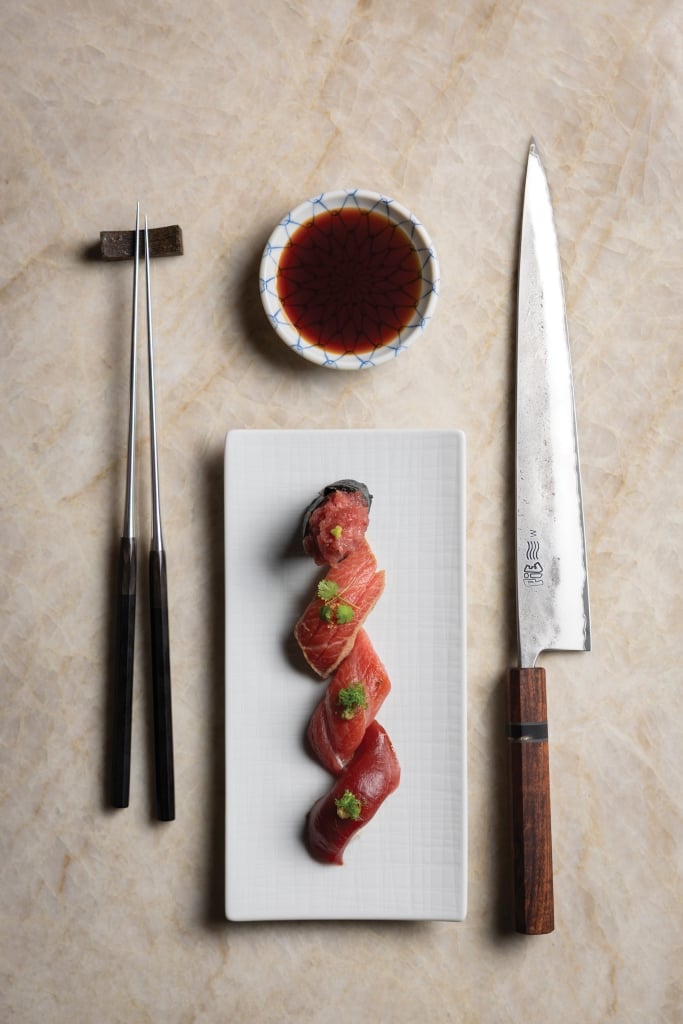
Sea Island Sushi Chef Jam Magtanong’s knife from Pie Cutlery.
Middleton Made Knives represents a complete understanding and reflection of this culinary necessity. Starting his business in 2003, Quintin Middleton grew from humble beginnings, knocking on doors just to get his knife in the hands and kitchens of chefs and home cooks. Through long-term grit and commitment to craftsmanship, Middleton has collaborated with critically acclaimed chefs such as Michael Symon, Marcus Samuelsson and Kwame Onwuachi to create a knife that mirrors their culinary genius. Blending his favorite eight-inch chef’s knife with a synthetic material handle, Middleton has forged a blade that serves as the “workhorse” in the kitchen.
“For a chef, the knife is an extension of the hand,” explains Danny Zeal, Culinary Director at Sea Island. “It’s all about performance and preference. Because everyone’s hand is different, some chefs prefer a certain size, a certain weight, a certain shape, with a specific handle material.” The curve of the handle might echo the natural grip of a person’s fingers, differing between right-handed and left-handed users. This individualization transforms the cooking experience, helping chefs master their cutting and chopping strokes, allowing them to work with unprecedented comfort and control.
The demand for hand-forged blades extends to home cooking enthusiasts who appreciate performance balanced with craftsmanship. In his home kitchen, Zeal displays and uses a set of Glestain knives. These professional-grade Japanese knives are known for their unique, scalloped blades, which reduce food sticking by creating air pockets and a smooth slicing motion. However, at work, he relies on a 10.5-inch Damascus-bladed knife he contracted from Haburn Knives in 2016. This knife is defined by its distinctive, wavy, “watered” pattern created by forge-welding layers of different steel together before acid-etching the blade to reveal patterns as unique as fingerprints.
“While I wouldn’t say the knife makes the chef, it’s not uncommon to see statement pieces in professional kitchens,” Zeal adds. “But functionality is critical for chefs and other culinary staff; knives are serious investments.”

Cattle Dog Forge Culinary Knives
Hand-forged blades remind us that some things are worth waiting for — tools that don’t just cut through ingredients or materials, but through time itself, carrying forward the ancient practice of using fire, steel and human skill to forge objects of function and beauty. These knives connect us not only to our work, but to the long chain of makers who understood that the best tools are created to serve for generations to come.
THE MAKING OF AN HEIRLOOM
Handcrafted knives are often prized for their distinctive character, but they are also known for offering superior performance over factory-made alternatives.
“Hand forged knives generally possess greater edge retention,” says Georgia knifemaker Bob Craven. When creating a blade by hand, processes like heat treatment have better control over reducing brittleness and achieving the final, desired balance of toughness and edge retention.
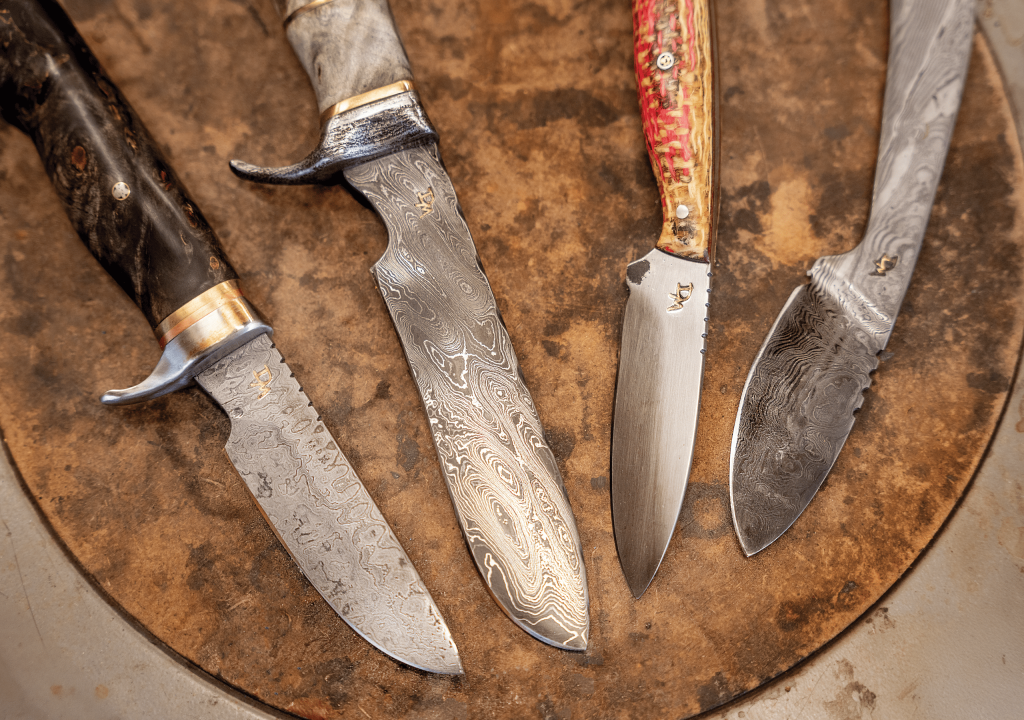
Sporting Knives from Cattle Dog Forge. Images Provided by Jason Thrasher
As for the handle, a wide range of materials such as bone, antler, wood and synthetics can be affixed to the blade, offering yet another opportunity for customization. Craven also touches on the task of joining a blade to a handle. Full tang features the blade’s metal extending through the handle, forming a single, continuous piece, versus a hidden tang, where a metal tab extends from the blade into the handle and is completely concealed.
Lee Barber, Director of Operations at Broadfield, a Sea Island Sporting Club and Lodge, wields a unique, full-tang knife crafted from the bill of a swordfish.
“Lee came to me with two bills and an idea of how he wanted his blade shaped, and we worked together to make exactly what he had in mind,” says Craven.
Knifemakers like Craven are guided by a “client-driven vision” as they work toward an end product. Lee Barber didn’t merely select a knife from a catalog; he arrived with a specific mental image of what he wanted his knife to look like. For many bladesmiths, the customer’s unique vision becomes the starting point.
Cooperation with the client may be the dawn of a new knife, but it takes collaborative efforts to secure a blade’s status as an invaluable heirloom. Daniel Moye works tirelessly to forge a knife with distinct precision that is simultaneously paired with the perfect sheath — a token to the powerful relationship of bladesmith and leathersmith. Moye has had a longstanding relationship with leathersmith Bud Siniard of Upland Custom Leather. Together, their deep understanding of each other’s craftsmanship sparks a fortified harmony between knife and sheath.
A handcrafted knife is more than a blade and a handle. It is a story of patience, tradition and artistry forged into something meant to last for generations, just as this practice has. As the modern bladesmithing renaissance continues, these custom creations will serve chefs, outdoorsmen and collectors alike while standing as heirlooms carrying the history of the makers for years to come.




